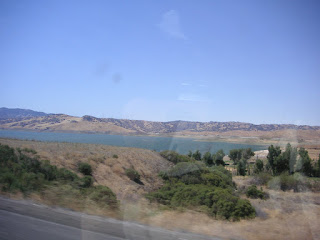August 25, 2012
Yellow, yellow... green? It felt like I had abruptly left black and white Kansas and ended up in Technicolor Munchkinland (see previous post). Instead of a yellow brick road, I had to pass through yellow grassy slopes. The first photo above is a decent comparison shot to the one I posted for November 24, 2011 when those shrubs in the foreground were submerged in water. I don't know if the level of the reservoir water is unusually low this summer given the lack of rain we had last winter.
It's funny, whenever I go through dry grassy CA hills, I see shapes of dinosaurs. This is based on a whole string of myths and erroneous connections from my childhood mind's eye. In the 1970's, I watched episodes of Mutual of Omaha's Wild Kingdom that incorrectly described how elephants traveled to graveyards to die and showed birds on hippos. I didn't make the distinction between large, leathery skinned mammals and dinosaurs. Then, thanks to Sinclair Oil's logo, I figured fossil fuels came from Brontosaurus (properly classified as Apatosaurus). I at least knew dinosaurs were extinct. So, during summer vacations to the coast as we passed through the Kettleman Hills, I came to the conclusion that numerous massive dinosaurs must have congregated there for their final die-off, were loosely covered with drifting dirt through thousands of years, formed the sloping hills with dried grassy blankets, turned into oil underneath, and now had pumpjacks like a flock of monstrous drinking birds on their backs. Ah, the wild imagination of children.
Speaking of the 1970's, I remember studying handout supplements in grade school for renewable energy as a result of the energy crisis. Over 30 years have passed since then, and our progress away from reliance on fossil fuels seems to be slow. Sure, there are two forms of green energy shown in the first picture of the San Luis Reservoir area, hydropower and wind power, but is that enough?
It's funny, whenever I go through dry grassy CA hills, I see shapes of dinosaurs. This is based on a whole string of myths and erroneous connections from my childhood mind's eye. In the 1970's, I watched episodes of Mutual of Omaha's Wild Kingdom that incorrectly described how elephants traveled to graveyards to die and showed birds on hippos. I didn't make the distinction between large, leathery skinned mammals and dinosaurs. Then, thanks to Sinclair Oil's logo, I figured fossil fuels came from Brontosaurus (properly classified as Apatosaurus). I at least knew dinosaurs were extinct. So, during summer vacations to the coast as we passed through the Kettleman Hills, I came to the conclusion that numerous massive dinosaurs must have congregated there for their final die-off, were loosely covered with drifting dirt through thousands of years, formed the sloping hills with dried grassy blankets, turned into oil underneath, and now had pumpjacks like a flock of monstrous drinking birds on their backs. Ah, the wild imagination of children.
Speaking of the 1970's, I remember studying handout supplements in grade school for renewable energy as a result of the energy crisis. Over 30 years have passed since then, and our progress away from reliance on fossil fuels seems to be slow. Sure, there are two forms of green energy shown in the first picture of the San Luis Reservoir area, hydropower and wind power, but is that enough?


3 comments:
Hmmm, this colour thing is an interesting way of conveying landscape and mood, a comment upon our ties to the world around us.
Today, with the rain clouds over a turgid peaty river, it will be mainly grey, grey, brown.
Hey, Graeme, please send some of that rain our way. It's been a challenge explaining how I'm very sensitive to weather and have allowed it to determine the course of my life, more than jobs or family. This particular day we experienced almost a 25°C change going from foggy coast to dry inland. Phew!
Ouch, that's a big change!
We've just returned from a short holiday in the Yorkshire dales. The weather alternated between cloudy and wet or sunny and dry. Sometimes several times a day, occasionally for 24 hours at a time. The temperature changes were within reasonably tolerable levels, so the only drawback was the fact that I didn't take the camera along as often as I would've liked.
Hope you're finding some thermal consistency!
Post a Comment